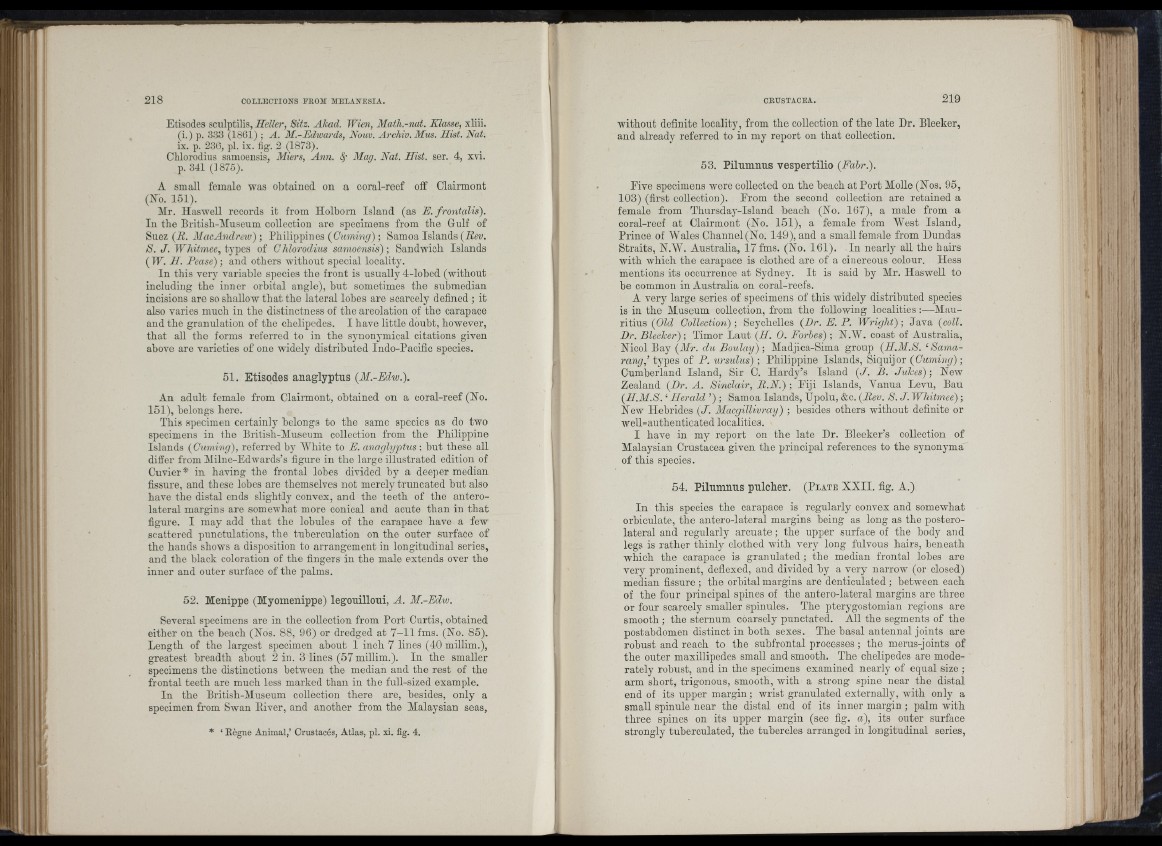
Ni
T =
I I
Etisodes sculptilis, Heller, Sitz. Akad. Wien, Matli.-nat. Klasse, xliii.
(i.) p. 3 3 3 (1861) ; A. Al.-Edwards, Nouv. Archiv. Mus. Hist. Nat.
ix. p . 2 3 6 , pl. ix. f i o - , 2 ( 1 8 7 3 ) .
Chlorodius samoensis, Miers, Ann. Sg May. Nat. Hist. ser. 4, xvi.
p . 341 (1875).
A small female was obtained on a coral-reef off Clairmont
(No. 151).
Mr. Haswell records it from Holborn Island (as E. frontalis).
In the British-Aluseum collection are specimens from the Gulf of
Suez (iZ. AlacAndrew); Philippines (Guminq) ; Samoa Islands (Dew.
S . J. Whitmee, typGS, of 0 hlorodius samoensis) ; Sandwich Islands
( W. H. Pease) ; and others without special locality.
In this very variable species the front is usually 4-lobed (without
including the inner orbital angle), but sometimes the submedian
incisions are so shallow th at the lateral lobes are scarcely defined ; it
also varies much in the distinctness of the areolation of the carapace
and the granulation of the chelipedes. I have little doubt, however,
that all the forms referred to in the synonymical citations given
above are varieties of one widely distributed Indo-Pacific species.
51. Etisodes anaglyptus (AI.-Edw.).
An adult female from Clairmont, ohtained on a coral-reef (No.
151), belongs here.
This specimen certainly belongs to the same species as do hvo
specimens in the British-Museum collection from the Philippine
Islands (Cuming), referred by AA*hite to E. anaglyptus ; hut these all
differ from Alilne-Edwards’s figure in the large illustrated edition of
Cuvier* in having the frontal lobes divided by a deeper median
fissure, and these lobes are themselves not merely truncated but also
have the distal ends slightly con^æx, and the teeth of the anterolateral
margins are somewhat more conical and acute than in th at
figure. I may add th at the lobules of the carapace have a few
scattered pnnctulations, the tuberculation on the outer surface of
the hands shows a disposition to arrangement in longitudinal series,
and the black coloration of the fingers in the male extends over the
inner and outer surface of the palms.
52. Menippe (Myomenippe) legonilloui, A . M.-Ediu.
Several specimens are in the collection from Port Curtis, ohtained
either on the beach (Nos. 88, 96) or dredged at 7-11 fms. (No. 85).
Length of the largest specimen about 1 inch 7 lines (40 millim.),
greatest breadth about 2 in. 3 lines (57 millim.). In the smaller
specimens the distinctions between the median and the rest of the
frontal teeth are much less marked than in the full-sized example.
In the British-Museum collection there are, besides, only a
specimen from Swan Eiver, and another from the Malaysian seas,
* ‘ Eègne Animal,’ Crustacés, Atlas, pi. xi. fig. 4.
without definite locality, from the collection of the late Dr. Bleeker,
and already referred to in my report on th a t collection.
53. Pilumnus vespertilio (Fair.).
Five specimens were collected on the beach at Port Molle (Nos. 95,
103) (first collection). Erom the second collection are retained a
female from Thursday-Island beach (No. 167), a male from a
coral-reef at Clairmont (No. 151), a female from AVest Island,
Prince of Wales Channel (No. 149), and a small female from Dundas
Straits, N.AV. Australia, 17 fms. (No. 161). In nearly all the hairs
with which the carapace is clothed are of a cinereous colour. Hess
mentions its occurrence at Sydney. I t is said by Mr. Haswell to
be common in Australia on coral-reefs.
A very large series of specimens of this widely distributed species
is in the Museum collection, from the following localities :—Alau-
ritins (Old Collection) ; Seychelles (Dr. E. P. W rig h t); Java (coll.
Dr. Bleelcer); Timor Laut (H. 0. Forhes); N.AV. coast of Australia,
Nicol Bay (Mr. du Boulay); Aladjica-Sima group (H.M.S. ‘Samarang,’
types of P. ursulus) ; Philippine Islands, Siquijor (Cuming);
Cumberland Island, Sir 0. Hardy’s Island (J. B. Juices); New
Zealand (Dr. A. Sinclair, B .N .) ; Eiji Islands, Vanua Levu, Ban
(H.Al.S. ‘ Herald ’) ; Samoa Islands, Upolu, &c. (Bev. S. J. Whitmee);
New Hebrides (J. Macgillivray) ; besides others without definite or
well-authenticated localities.
I have in my report on the late Dr. Bleeker’s collection of
Malaysian Crustacea given the principal references to the synonyma
of this species.
54. Pilumnus pulcher. (P late X X II. fig. A.)
In this species the carapace is regularly convex and somewhat
orbiculate, the antero-lateral margins being as long as the posterolateral
and regularly a rcu a te ; the upper surface of the body and
legs is rather thinly clothed with very long fulvous hairs, beneath
which the carapace is gran u lated; the median frontal lobes are
very prominent, deflexed, and divided by a very narrow (or closed)
median fissure ; the orbital margins are denticulated ; between each
of the four principal spines of the antero-lateral margins are three
or four scarcely smaller spinules. The pterygostomian regions are
smooth; the sternum coarsely punctated. All the segments of the
postabdomen distinct in both sexes. The basal antennal joints are
robust and reach to the subfrontal processes ; the merus-joints of
the outer maxillipedes small and smooth. The chelipedes are moderately
robust, and in the specimens examined nearly of equal size ;
arm short, trigonous, smooth, with a strong spine near the distal
end of its upper margin; wrist granulated externally, with only a
small spinule near the distal end of its inner margin ; palm with
three spines on its upper margin (see fig. a), its outer surface
strongly tuberculated, the tubercles arranged in longitudinal series,
( !
P nil
ij
■ I '
'I I
i I
! ■J
t I ^ * i
I}'
•.I. 'I I
I !
O'M
l
)i :
i r
: i ' f
'